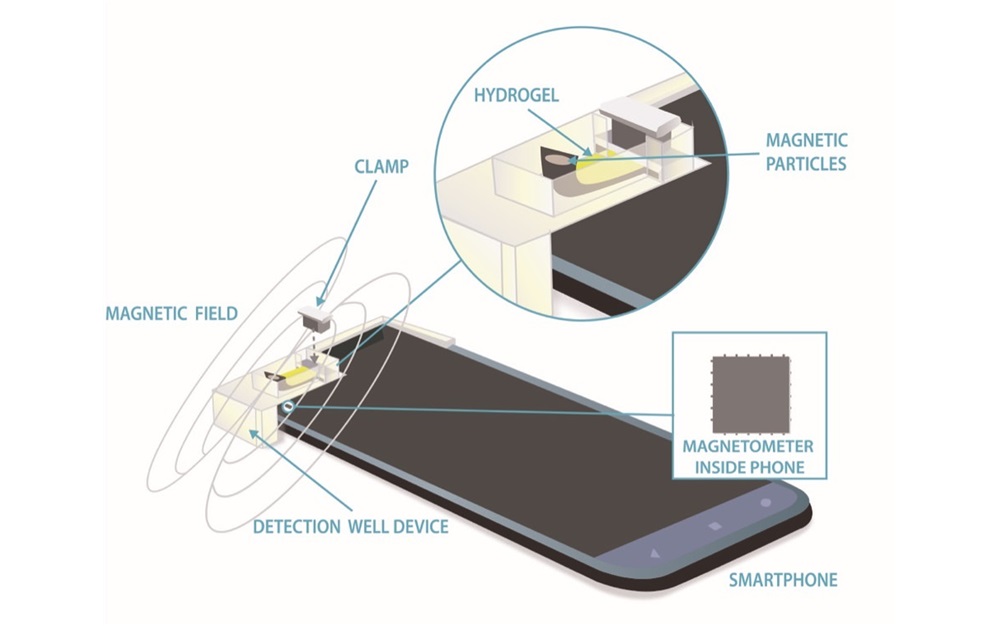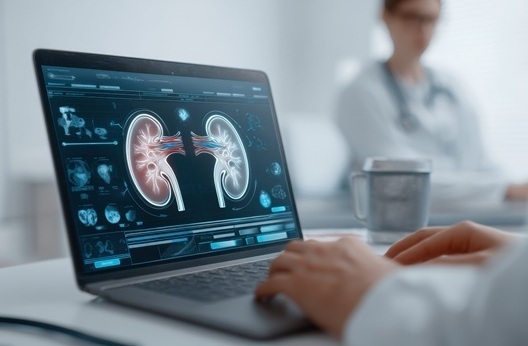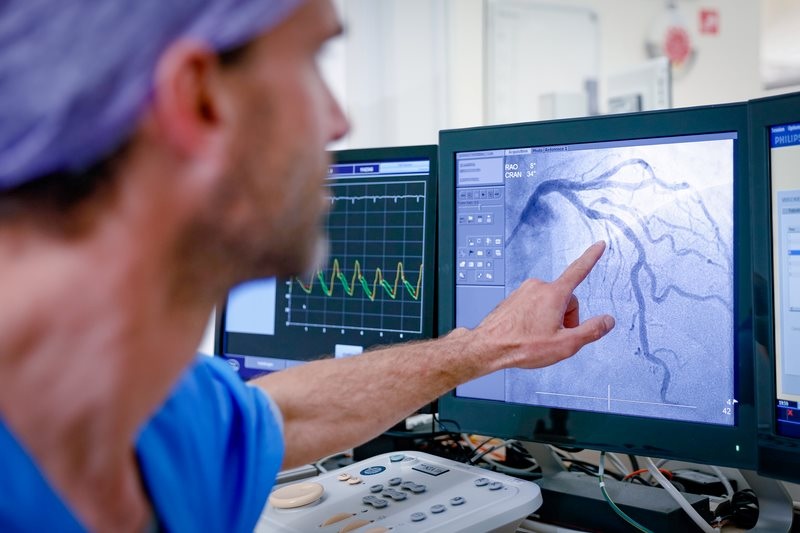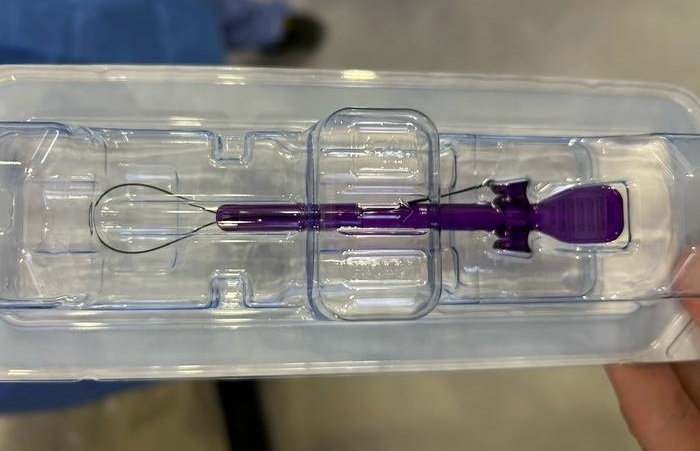Smartphone Magnetometer Uses Magnetized Hydrogel to Measure Biomarkers for Disease Diagnosis
|
By HospiMedica International staff writers Posted on 03 Apr 2024 |

Almost every modern smartphone incorporates a compass or magnetometer, which senses Earth's magnetic field, crucial for navigation purposes. Now, a newly developed technique uses an ordinary cellphone magnetometer to precisely measure glucose levels, an important diabetes indicator. This approach, combined with magnetic materials that change their shape in reaction to biological or environmental stimuli, can be employed to assess a wide array of biomedical properties crucial for human disease monitoring or diagnosis, as well as detecting environmental pollutants.
In their proof-of-concept study, a team of researchers at the National Institute of Standards and Technology (NIST, Gaithersburg, MD, USA) attached a tiny well filled with the test solution and a hydrogel strip, to a smartphone. This hydrogel, a porous material that swells when immersed in water, was embedded with tiny magnetic particles engineered to respond to glucose presence or pH changes by swelling or contracting. Changing pH levels is associated with various biological disorders. When the hydrogels enlarged or shrank, they forced the magnetic particles to come closer to or go farther from the cellphone’s magnetometer, which detected the corresponding changes in the strength of the magnetic field. Utilizing this innovative approach, the team succeeded in measuring glucose concentrations as small as a few millionths of a mole levels. Although such high sensitivity is not needed for home glucose monitoring using blood tests, it could pave the way for saliva-based glucose testing, where sugar concentration is notably lower.
The method's simplicity, without the need for any additional electronics or power sources except for the smartphone or requirement for sample processing, presents an economical solution for widespread testing, even in resource-limited areas. Future potential improvements in measuring accuracy through smartphone magnetometers could lead to detection of DNA, specific proteins, and histamines — key immune response elements — at extremely low concentrations. For example, accurately measuring histamines, typically found in urine at concentrations ranging from about 45 to 190 nanomoles, would usually require a 24-hour urine collection and complex lab analyses. Similarly, the team found that a cellphone magnetometer can measure pH levels with sensitivity equal to a thousand-dollar benchtop meter but at a substantially lower cost. To make smartphone-based measurements a market success, engineers will have to devise a mass-production strategy for the hydrogel test strips and ensure their long shelf life.
Related Links:
NIST
Latest Critical Care News
- EEG-Based AI Technology Accurately Diagnoses Alzheimer’s and Dementia
- Robot Lymphatic System Paves Way for Self-Powered Wearables and Machines
- Focused Ultrasound Technique Successfully Treats Pediatric Brain Cancer
- Nasal Drops Fight Brain Tumors Noninvasively
- AI Helps Optimize Therapy Selection and Dosing for Septic Shock
- Glowing Bacteria ‘Pills’ for Detecting Gut Diseases Could Eliminate Colonoscopies
- Skin-Permeable Polymer Patch Delivers Insulin Non-Invasively Through Skin
- Nanogel Technology Almost 100% Effective in Destroying Drug-Resistant Bacteria Within Hours
- Wearable Ultrasound Sensor Delivers Noninvasive Treatment Without Surgery
- Gel-Free ECG System to Transform Heart Health Diagnosis
- Biodegradable Patch Repairs Damaged Tissue After Heart Attack
- Magnetically Guided Microrobots to Enable Targeted Drug Delivery

- Smart Nanomaterials Detect and Treat Traumatic Brain Injuries Simultaneously
- Earlier Blood Transfusion Could Reduce Heart Failure and Arrhythmia in Heart Disease Patients
- 'Smart' Shirt Detects Epileptic Seizures in Real Time
- Skin Patch Measures Effectiveness of Flu/COVID Vaccines in 10 Minutes
Channels
Surgical Techniques
view channelLaparoscopic Surgery Improves Outcomes for Severe Newborn Liver Disease
Biliary atresia is a rare but life-threatening liver condition in newborns that blocks bile flow and leads to progressive liver damage if not treated early. Surgery is typically performed within the first... Read moreNovel Endoscopy Technique Provides Access to Deep Lung Tumors
Detecting lung cancer early can save lives, but diagnosing small tumors deep in the outer regions of the lungs remains a major clinical challenge. Although CT scans frequently identify tiny suspicious... Read morePatient Care
view channel
Revolutionary Automatic IV-Line Flushing Device to Enhance Infusion Care
More than 80% of in-hospital patients receive intravenous (IV) therapy. Every dose of IV medicine delivered in a small volume (<250 mL) infusion bag should be followed by subsequent flushing to ensure... Read more
VR Training Tool Combats Contamination of Portable Medical Equipment
Healthcare-associated infections (HAIs) impact one in every 31 patients, cause nearly 100,000 deaths each year, and cost USD 28.4 billion in direct medical expenses. Notably, up to 75% of these infections... Read more
Portable Biosensor Platform to Reduce Hospital-Acquired Infections
Approximately 4 million patients in the European Union acquire healthcare-associated infections (HAIs) or nosocomial infections each year, with around 37,000 deaths directly resulting from these infections,... Read moreFirst-Of-Its-Kind Portable Germicidal Light Technology Disinfects High-Touch Clinical Surfaces in Seconds
Reducing healthcare-acquired infections (HAIs) remains a pressing issue within global healthcare systems. In the United States alone, 1.7 million patients contract HAIs annually, leading to approximately... Read moreHealth IT
view channel
EMR-Based Tool Predicts Graft Failure After Kidney Transplant
Kidney transplantation offers patients with end-stage kidney disease longer survival and better quality of life than dialysis, yet graft failure remains a major challenge. Although a successful transplant... Read more
Printable Molecule-Selective Nanoparticles Enable Mass Production of Wearable Biosensors
The future of medicine is likely to focus on the personalization of healthcare—understanding exactly what an individual requires and delivering the appropriate combination of nutrients, metabolites, and... Read moreBusiness
view channel
Philips and Masimo Partner to Advance Patient Monitoring Measurement Technologies
Royal Philips (Amsterdam, Netherlands) and Masimo (Irvine, California, USA) have renewed their multi-year strategic collaboration, combining Philips’ expertise in patient monitoring with Masimo’s noninvasive... Read more
B. Braun Acquires Digital Microsurgery Company True Digital Surgery
The high-end microsurgery market in neurosurgery, spine, and ENT is undergoing a significant transformation. Traditional analog microscopes are giving way to digital exoscopes, which provide improved visualization,... Read more
CMEF 2025 to Promote Holistic and High-Quality Development of Medical and Health Industry
The 92nd China International Medical Equipment Fair (CMEF 2025) Autumn Exhibition is scheduled to be held from September 26 to 29 at the China Import and Export Fair Complex (Canton Fair Complex) in Guangzhou.... Read more















